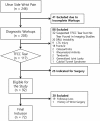What is the Natural History of the Triangular Fibrocartilage Complex Tear Without Distal Radioulnar Joint Instability?
- PMID: 30376460
- PMCID: PMC6370105
- DOI: 10.1097/CORR.0000000000000533
What is the Natural History of the Triangular Fibrocartilage Complex Tear Without Distal Radioulnar Joint Instability?
Abstract
Background: The triangular fibrocartilage complex (TFCC) tear is a common cause of ulnar-side wrist pain; however, its natural course is not well understood.
Questions/purposes: We sought (1) to determine the natural course of TFCC tears without distal radioulnar joint (DRUJ) instability, and (2) to identify the factors associated with poor prognosis after nonsurgical treatment of TFCC tears.
Methods: Over a 3-year period, we treated 117 patients with TFCC tears who did not have DRUJ instability. The diagnosis was made on the basis of ulnar-sided wrist pain, a positive ulnocarpal stress test or ulnar grinding test, and identification of a tear on MRI or CT arthrography. Of those, 25 were excluded during the initial evaluation period because they met the previously defined indications of surgery on the basis of clinical history. Another 19 patients (20%) were lost to followup before 6 months, and one patient was excluded because of prior wrist surgery, leaving 72 wrists in 72 patients for analysis in this retrospective study, which drew data from a review of electronic medical records of one institution. The group consisted of 42 men and 30 women, with a mean age of 40 years (range, 18-70 years). The study group was followed for a mean of 16 months (range, 6 to 36 months). We evaluated the pain VAS and patient-rated wrist evaluation (PRWE) at the initial visit, at 4, 8, and 12 weeks, and at more than 6 months after the initial visit. A PRWE score ≤ 20 points indicated complete recovery, and a PRWE score more than 20 points was considered an incomplete recovery. We used Kaplan-Meier survival analysis and Cox regression modelling to estimate the time to complete recovery and to identify factors associated with incomplete recovery among the seven possible factors of older age (≥ 45 years), male, obesity (body mass index ≥ 30 kg/m), dominant-hand involvement, chronic symptoms (≥ 6 months), traumatic tear, and ulnar-plus variance.
Results: The Kaplan-Meier survival analysis showed that estimated cumulative incidence of complete recovery was 30% (95% confidence interval [CI], 20-40) at 6 months and 50% (95% CI, 39-61) at 1 year. We could not find any risk factors among the seven candidate factors, including older age (hazard ratio [HR], 0.608; 95% CI, 0.34-1.087; p = 0.093), male (HR, 1.152; 95% CI, 0.667-1.991; p = 0.612), obesity (HR, 1.433; 95% CI, 0.603-3.402; p = 0.415), dominant hand involvement (HR, 1.808; 95% CI, 0.927-3.527; p = 0.082), chronic symptoms (HR, 0.763; 95% CI, 0.443-1.922; p = 0.133), traumatic tear (HR, 0.756; 95% CI, 0.432-1.32; p = 0.325), and ulnar plus variance (HR, 0.804; 95% CI, 0.461-1.404; p = 0.443).
Conclusions: This study demonstrates that nonsurgical treatment is moderately successful for treating patients with TFCC tears without DRUJ instability. We recommend a minimum of 6 months nonsurgical treatment as the first-line treatment for this injury. Future studies are necessary to clarify predictors of persistent pain with nonsurgical treatment to avoid an unnecessary surgical delay.
Level of evidence: Level III, prognostic study.
Conflict of interest statement
Each author certifies that neither he, nor any member of his immediate family, have funding or commercial associations (consultancies, stock ownership, equity interest, patent/licensing arrangements, etc) that might pose a conflict of interest in connection with the submitted article.
All ICMJE Conflict of Interest Forms for authors and
Figures



Comment in
-
CORR Insights®: What is the Natural History of the Triangular Fibrocartilage Complex Tear Without Distal Radioulnar Joint Instability?Clin Orthop Relat Res. 2019 Feb;477(2):450-451. doi: 10.1097/CORR.0000000000000587. Clin Orthop Relat Res. 2019. PMID: 30624317 Free PMC article. No abstract available.
References
-
- Altman DG. Statistics in medical journals: some recent trends. Stat Med. 2000;19:3275-3289. - PubMed
-
- Bohringer G, Schadel-Hopfner M, Petermann J, Gotzen L. A method for all-inside arthroscopic repair of Palmer 1B triangular fibrocartilage complex tears. Arthroscopy. 2002;18:211-213. - PubMed
-
- Friedman SL, Palmer AK. The ulnar impaction syndrome. Hand Clin. 1991;7:295-310. - PubMed
MeSH terms
LinkOut - more resources
Full Text Sources
Medical
Research Materials
Miscellaneous

